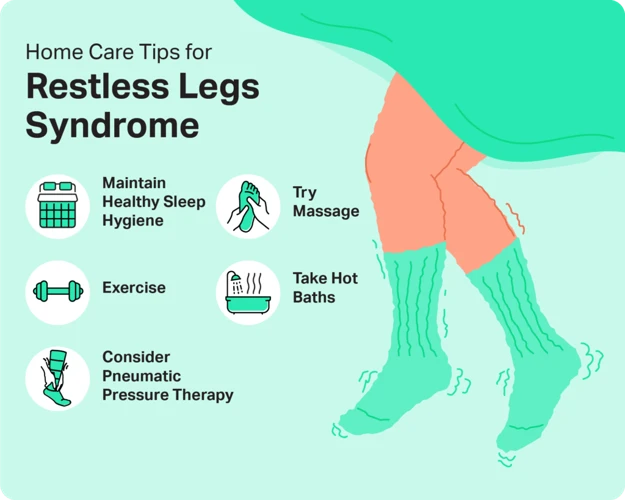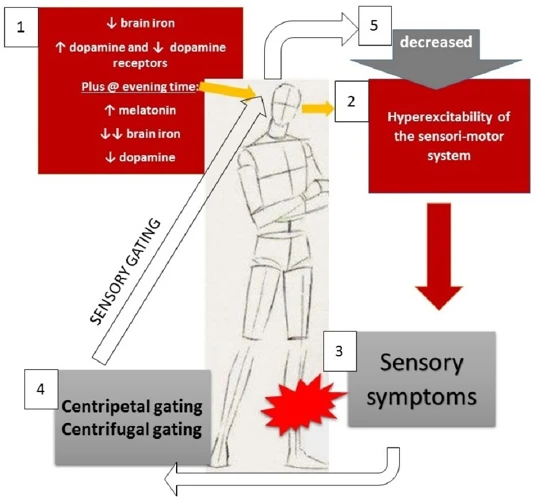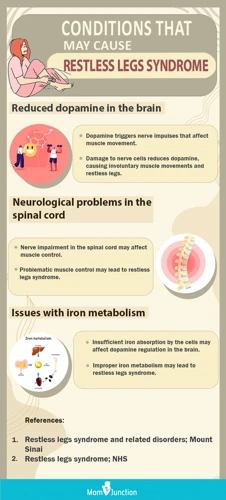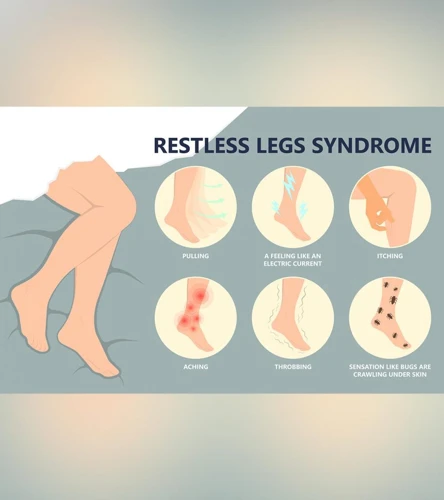Have you ever noticed your child moving their legs incessantly while trying to sleep? Or heard complaints of a strange sensation in their limbs that just won’t go away? Restless Leg Syndrome (RLS) might be the culprit behind these difficulties. RLS is a common condition that affects both adults and children, leading to discomfort and disturbance in sleep. In this article, we’ll explore what RLS is, the signs and symptoms of RLS in children, the causes of RLS in children, and most importantly, management strategies to help your child get relief from this affliction.
What is Restless Leg Syndrome?

Restless Leg Syndrome (RLS) is a condition characterized by an uncontrollable urge to move the legs, usually accompanied by unpleasant sensations such as crawling, itching or tingling. This condition is often seen in adults, but it can also affect children. It can be quite distressing and disruptive, especially when it comes to sleep. In the following section, we’ll delve deeper into the nature of RLS, its signs and symptoms, and the causes that can trigger it in children.
Overview of Restless Leg Syndrome (RLS)
Restless Leg Syndrome (RLS) is a neurological condition that is characterized by an irresistible urge to move the legs when resting or trying to fall asleep. This urge is often accompanied by uncomfortable sensations in the legs, such as crawling, creeping, itching, pulling or throbbing.
Here are some key points about RLS:
- RLS affects both children and adults, but it is more common in women and children.
- It can occur at any age, but it is more common in middle-aged and elderly people.
- RLS can be mild or severe, and may come and go or be continuous.
- RLS can have a significant impact on quality of life, causing sleep disturbances, fatigue, daytime sleepiness and mood disturbances.
Here are some common triggers for RLS:
- Sitting or lying down for long periods of time
- Physical inactivity
- Stress, anxiety or depression
- Caffeine or alcohol consumption
- Poor sleep quality
- Pregnancy (especially in the third trimester)
Research suggests that RLS may be linked to:
- Genetics: family history of RLS is a common risk factor
- An imbalance of dopamine in the brain, a neurotransmitter that controls movement
- Iron deficiency or anemia
- Chronic diseases, such as kidney failure, diabetes, and Parkinson’s disease
It is important for parents and caregivers to recognize the signs and symptoms of RLS in children in order to seek appropriate diagnosis and management strategies.
Signs and Symptoms of RLS in Children
Restless Leg Syndrome (RLS) in children can be difficult to diagnose as they may have trouble describing their symptoms. However, there are certain signs and symptoms that parents and caregivers should look out for. Here are the most common signs and symptoms of RLS in children:
- An urge to move the legs: This is often described as an uncomfortable sensation that begins in the legs and is relieved only by movement.
- Difficulty falling and staying asleep: Children with RLS often have trouble falling asleep and staying asleep. They may also wake up frequently during the night.
- Frequent leg movements during sleep: Children with RLS may move their legs constantly during sleep, which can disrupt their own sleep and that of others.
- Irritability and mood swings: Children with RLS may experience irritability and mood swings due to their lack of sleep and discomfort.
- Inattention and hyperactivity: Sleep deprivation caused by RLS can affect a child’s ability to pay attention and can make them more hyperactive.
- Daytime fatigue: Children with RLS may feel tired and lethargic during the day as a result of poor sleep quality.
If your child is experiencing one or several of these symptoms on a regular basis, it is important to consult a healthcare professional for a proper diagnosis and treatment plan.
Causes of RLS in Children
Restless Leg Syndrome (RLS) is a neurological disorder that affects children as well as adults. While the exact cause of RLS is not known, there are certain risk factors that may increase the likelihood of developing the condition. Here are some potential causes of RLS in children:
| Causes of RLS in Children | Description |
|---|---|
| Anemia | A lack of iron in the blood can cause RLS in children. Iron is necessary for the brain to produce dopamine, a neurotransmitter that helps regulate movement. |
| Genetics | RLS has a genetic component and may be passed down from parents to their children. |
| Neurological Disorders | Children with neurological disorders such as attention deficit hyperactivity disorder (ADHD), autism, and cerebral palsy are more likely to develop RLS. |
| Medications | Certain medications used to treat other conditions can trigger RLS symptoms in children. These medications include antidepressants, antipsychotics, anticonvulsants, and some cold and allergy medications. |
| Growing Pains | RLS symptoms can sometimes be confused with growing pains, which are common in children. However, growing pains typically occur in the muscles rather than the bones and joints, and they do not cause the same irresistible urge to move that RLS does. |
It is important to note that not all cases of RLS have a clear cause, and some children may have a combination of factors that contribute to their symptoms. A thorough medical evaluation and diagnostic testing can help pinpoint the underlying cause of RLS in children.
Diagnosing Restless Leg Syndrome in Children

When it comes to diagnosing Restless Leg Syndrome in children, it can be a challenging task for healthcare providers. This condition is not always easily recognizable, and its symptoms are often misunderstood or misdiagnosed. However, with proper medical evaluation and diagnostic tests, RLS can be accurately diagnosed, allowing the child to receive appropriate management strategies and improve their quality of life. Let’s explore the various methods used for diagnosing RLS in children.
Medical Evaluation
When a child is experiencing symptoms that suggest Restless Leg Syndrome (RLS), it’s important to obtain a thorough medical evaluation to determine the cause of their discomfort. Here are some steps medical professionals may take during the evaluation process:
- Medical history: The doctor will ask about the child’s symptoms, when they occur, how severe they are, and if there are any factors that relieve or worsen them. They may also ask about the child’s medical history and any family history of RLS.
- Physical exam: The doctor will examine the child’s legs to look for signs of any potential underlying conditions that may be causing RLS.
- Iron levels: Blood tests may be ordered to check the child’s iron levels. Low levels of iron have been linked to RLS.
- Neurological exam: The doctor may perform a neurological exam to check the child’s nerve function and reflexes.
These steps can help identify if the child has RLS or if there may be an underlying condition causing their discomfort. It’s important to note that there is currently no specific test to diagnose RLS, but a combination of medical history, physical exam, and diagnostic tests can help determine the best course of treatment for the child.
Diagnostic Tests
Once a medical evaluation has been conducted and the doctor suspects that the child may have Restless Leg Syndrome (RLS), diagnostic tests may be ordered to confirm the diagnosis. These tests can be helpful in ruling out other conditions that may have similar symptoms to RLS.
1. Blood tests: blood tests may be done to check for iron, folate, and magnesium levels in the blood. Low levels of these minerals have been associated with RLS.
2. Urine tests: urine tests may be conducted to check for kidney function and to rule out kidney disease as a cause of RLS.
3. Sleep studies: a sleep study, also known as a polysomnography, may be ordered if the child is also experiencing sleep disturbances. This test measures the child’s brain waves, heartbeat, and breathing during sleep to check for any abnormalities.
4. Doppler ultrasound: a doppler ultrasound may be done to check for any obstruction in blood vessels in the legs.
5. Electromyography (EMG): this test measures the electrical activity of muscles during movement and may be used to rule out other neurological conditions that may cause similar symptoms to RLS.
It is important to note that not every child with RLS will require diagnostic tests. The decision to conduct tests will depend on the child’s individual case and the doctor’s clinical judgment.
Management Strategies for Restless Leg Syndrome in Children

When it comes to managing Restless Leg Syndrome (RLS) in children, there are a variety of strategies available. From lifestyle changes to medical treatments, there are many options to help alleviate the symptoms that can make bedtime a struggle for both the child and their parents. Alternative therapies can also offer relief for some children, providing additional options for families seeking a comprehensive approach to RLS management. In this section, we will explore these various strategies in depth, providing an overview of each option and outlining how it can be used to help children with RLS.
Lifestyle Changes
Making lifestyle changes can greatly improve a child’s symptoms of Restless Leg Syndrome. Here are some tips for managing RLS symptoms through lifestyle changes:
| Tips for Lifestyle Changes |
|---|
| Avoid caffeine, especially in the afternoon and evening. Caffeine is a known stimulant and can make RLS symptoms worse. |
| Make sure your child gets enough exercise during the day but avoids vigorous exercise in the evening. Exercise can help reduce RLS symptoms, but exercising too close to bedtime can make it harder for your child to fall asleep. |
| Establish a regular sleep schedule. Going to bed and waking up at the same time every day can help regulate your child’s body clock and reduce RLS symptoms. |
| Encourage your child to use relaxation techniques before bedtime, such as deep breathing or meditation. These techniques can help calm the body and reduce RLS symptoms. |
| Practice good sleep hygiene. Make sure your child’s sleep environment is comfortable and conducive to restful sleep. Keep the room quiet, dark, and cool, and make sure your child has a comfortable mattress and pillow. |
| Consider using compression stockings or socks to help improve blood flow and reduce RLS symptoms. These garments can be worn during the day or at night. |
By implementing these lifestyle changes, you may be able to reduce your child’s RLS symptoms and improve their sleep. However, if your child’s symptoms persist, medical treatment may be necessary.
Medical Treatment
One of the options for managing restless leg syndrome (RLS) in children is medical treatment. However, medication should only be used after consultation with a healthcare provider.
Medication
There are several medications that have been used to treat RLS in children including:
| Medication | Description | Possible Side Effects |
|---|---|---|
| Dopaminergic agents | Augment the effects of dopamine in the brain | Nausea, vomiting, dizziness, daytime sleepiness, hallucinations, and sometimes impulse control disorders, such as compulsive gambling |
| Gabapentin and pregabalin | Anticonvulsant medications that also reduce RLS symptoms | Weight gain, dizziness, and drowsiness |
| Iron supplements | If iron deficiency is contributing to RLS, iron supplements may be recommended | Upset stomach, constipation, and nausea |
| Opioids | If other medications have been ineffective, opioids may be prescribed | Nausea, dizziness, and constipation |
It’s important to note that medication should not be the first line of treatment for children with RLS, and careful consideration of the risks and benefits must be evaluated before any medication is prescribed. Additionally, regular monitoring and dose adjustments may be necessary.
Medical Procedures
Medical procedures are rarely used to manage RLS in children. However, if a child has severe RLS symptoms that significantly impact their quality of life and medication has been ineffective, a deep brain stimulation procedure may be considered. This procedure involves implanting electrodes in the brain that stimulate the nerves that control RLS.
Alternative Therapies
When it comes to managing restless leg syndrome (RLS) in children, alternative therapies can play a significant role in reducing symptoms and improving overall well-being.
Acupuncture: This traditional Chinese medicine involves inserting thin needles into specific points on the body to improve energy flow and alleviate symptoms. Some studies have shown that acupuncture may be effective in reducing RLS symptoms, but more research is needed.
Meditation: Mindfulness meditation has been shown to improve symptoms of RLS in some individuals. Practicing meditation regularly can help calm the mind and reduce stress levels, which can trigger RLS symptoms.
Yoga: Certain yoga poses and breathing exercises can help alleviate RLS symptoms by improving circulation and promoting relaxation. However, individuals should talk to their healthcare provider before starting a new yoga practice.
Aromatherapy: Using essential oils such as lavender, chamomile, and peppermint can promote relaxation and reduce stress levels, which can help reduce RLS symptoms. Aromatherapy can be done by diffusing essential oils, adding them to a bath, or applying them topically.
Massage: Regular massages can help improve circulation and reduce muscle tension, which can alleviate RLS symptoms. Massages can also help promote relaxation and improve overall well-being.
It’s important to note that while alternative therapies can be helpful in managing RLS symptoms, they should not replace conventional medical treatment. It’s crucial to talk to a healthcare provider before trying any alternative therapies, especially if your child is taking medication to manage their RLS.
Helping Your Child Sleep Better

Having a child with restless leg syndrome can be challenging for both the child and parents. One of the main issues is disrupted sleep due to the uncomfortable sensations that come with this condition. As a parent, it’s important to help your child establish healthy sleep habits to ensure they get the rest they need. In this section, we’ll explore some useful strategies that you can use to help your child sleep better despite their restless leg syndrome.
Bedtime Routine
Establishing a consistent bedtime routine can be helpful for children with restless leg syndrome, as it can promote relaxation and help prepare their bodies for sleep. Here are some suggestions for a calming bedtime routine:
| Activity | Explanation |
|---|---|
| Bath time | Warm baths can relax muscles and promote a sense of calm. |
| Reading time | Reading a book together can be a calming and enjoyable activity for both parent and child. Choose a book that is not too stimulating or exciting. |
| Stretching | Gentle stretching exercises can help ease muscle tension and promote relaxation. |
| Guided relaxation techniques | Teaching your child breathing exercises or visualization techniques can help them feel calmer and more relaxed. |
| Affirmations | Repeating positive affirmations, such as “I am relaxed and calm,” can help your child feel more at ease and mentally prepare for sleep. |
It’s important to keep in mind that every child is different, so you may need to adjust the routine to fit your child’s specific needs and interests. The key is to consistently engage in calming and relaxing activities in the hour or two leading up to bedtime, to reinforce a sense of calm and preparation for sleep.
Creating a Sleep-Conducive Environment
Creating a Sleep-Conducive Environment is important for children with Restless Leg Syndrome (RLS) as it can help improve their quality of sleep. Here are some tips on how to create a comfortable sleep environment for your child:
| Tip 1 | Keep the room quiet and peaceful. Eliminate any loud noises and distractions that may keep your child up at night. Consider using white noise or soothing sounds to help drown out any background noises. |
| Tip 2 | Make sure the room is dark. Use room darkening shades, curtains or blinds to block out any light that may interfere with your child’s sleep. You can also use a sleep mask if your child is sensitive to light. |
| Tip 3 | Ensure the room is cool and comfortable. Maintain a cool temperature, ideally between 60-67°F (15-19.4°C), to help your child sleep better. Make sure your child has comfortable bedding and sleepwear without being too warm or too cold. |
| Tip 4 | Create a comfortable bed. Make sure your child’s bed is comfortable and supportive. Choose a mattress that provides good support and pillows that are comfortable and not too high or too low. |
| Tip 5 | Encourage your child to wind down before bedtime. Establish a relaxing pre-sleep routine that helps your child wind down before bed. This may include taking a warm bath, reading a book or listening to calming music. |
| Tip 6 | Avoid electronic gadgets. Encourage your child to avoid using electronic gadgets such as phones, tablets or computers before bedtime, as the blue light emitted by these devices can interfere with your child’s sleep. |
By following these tips, you can create a comfortable and peaceful sleep environment that may help your child with RLS sleep better and wake up feeling refreshed.
Encouraging a Positive Mindset
Encouraging a Positive Mindset can be helpful for children with Restless Leg Syndrome to improve their sleep quality. Here are some strategies that can be used to encourage a positive mindset:
| Strategy | Description |
| Cognitive Behavioral Therapy (CBT) | CBT is a type of therapy that focuses on changing negative thought patterns and behaviors. It can help children with RLS to develop a more positive mindset and reduce anxiety and stress that can worsen their symptoms. |
| Positive Affirmations | Encouraging positive self-talk can be helpful for children with RLS who may feel frustrated or discouraged by their symptoms. Parents and caregivers can help children to create positive affirmations, such as “I am calm and relaxed”, “My body is resting peacefully”, or “I am comfortable and at ease”. |
| Mindfulness Meditation | Mindfulness meditation can help children to focus on the present moment and reduce anxiety and stress. Parents and caregivers can teach children breathing exercises or guided meditations that encourage a calm and peaceful mindset. |
| Visualizations | Visualizations can help children to relax and reduce anxiety. Parents and caregivers can encourage children to imagine a peaceful scene, such as a beach or a forest, and to focus on the sounds, smells, and sensations of the scene. This can help children to feel more relaxed and less focused on their RLS symptoms. |
Encouraging a positive mindset can be an effective part of a holistic approach to managing RLS in children. By reducing stress and anxiety and promoting relaxation, children may experience fewer and less severe symptoms, allowing for better sleep and improved overall health.
Preventing Restless Leg Syndrome in Children
Parents and caregivers can take several measures to prevent restless leg syndrome in children. Ensuring that children have healthy sleep habits is crucial, as lack of sleep or poor quality sleep can exacerbate the symptoms of RLS. It is important to establish a regular sleep schedule and routine for your child. This includes setting a consistent bedtime and wake-up time each day, as well as having a calming bedtime routine that includes activities like reading or listening to soft music before sleeping.
Additionally, creating a sleep-conducive environment can also help prevent RLS in children. The bedroom should be dark, quiet, cool, and comfortable. Use comfortable pillows and blankets to create a cozy sleeping environment. It is also important to limit exposure to electronics in the hour leading up to bedtime, as the blue light from screens can interfere with sleep quality and make it more challenging for children to fall asleep.
Encouraging physical activity during the day can also help prevent restless leg syndrome in children. Regular exercise helps to alleviate stress and tension in the body, which can exacerbate the symptoms of RLS. Encourage your child to engage in physical activities they enjoy, such as dancing, swimming, or biking. Additionally, limiting caffeine and sugar intake can also help prevent RLS symptoms, as these substances can disrupt sleep patterns and contribute to restless nights.
Finally, it is important to seek medical attention if you suspect your child may be experiencing symptoms of restless leg syndrome. Early detection and treatment can reduce the severity of RLS symptoms and help your child get a better night’s sleep. Your child’s healthcare provider can recommend lifestyle changes or medications to manage the symptoms of restless leg syndrome in children. By adopting healthy sleep habits and lifestyle choices, parents can help prevent restless leg syndrome and promote overall health and wellness in their children.
Conclusion
In conclusion, Restless Leg Syndrome can be a challenging condition for parents and children to cope with. However, there are several management strategies that can help alleviate symptoms and improve overall quality of life. These strategies range from lifestyle changes to medical treatment to alternative therapies.
It’s important for parents to work closely with their child’s healthcare provider to properly diagnose RLS and determine the best course of treatment. This may involve undergoing medical evaluations and diagnostic tests to rule out other conditions that could be contributing to the symptoms.
For many children, simple lifestyle changes such as regular exercise and a healthy diet can make a big difference in managing symptoms of RLS. Additionally, creating a sleep-conducive environment and establishing a consistent bedtime routine can help promote better sleep and reduce nighttime agitation.
For children with more persistent symptoms, medical treatment options such as medications or iron supplements may be prescribed. In some cases, alternative therapies such as acupuncture or massage therapy may also be effective in alleviating symptoms of RLS.
Preventing RLS in children can be challenging, but identifying and treating underlying medical conditions and establishing healthy lifestyle habits can help reduce the risk of developing the condition.
While RLS can be a frustrating and uncomfortable condition, there are ways for parents and children to effectively manage symptoms and improve overall quality of life. With the right management strategies, children with RLS can enjoy restful and peaceful sleep and reduce the impact that this condition has on their daily lives.
Frequently Asked Questions
What age group is most commonly affected by restless leg syndrome?
Restless leg syndrome can occur at any age, but it is more common in middle-aged and older adults, as well as in children and adolescents.
What are the main symptoms of restless leg syndrome in children?
The main symptoms of restless leg syndrome in children include a strong urge to move their legs, uncomfortable sensations in their legs, and difficulty falling asleep or staying asleep.
What are some common causes of restless leg syndrome in children?
Common causes of restless leg syndrome in children include iron deficiency, genetics, and certain medications. In some cases, the cause may be unknown.
How is restless leg syndrome diagnosed in children?
Diagnosing restless leg syndrome in children typically involves a medical evaluation and a review of their symptoms. They may also undergo certain diagnostic tests, such as a sleep study or blood tests.
What lifestyle changes can help manage restless leg syndrome in children?
Lifestyle changes that may help manage restless leg syndrome in children include regular exercise, avoiding caffeine and other stimulants, and maintaining a regular sleep schedule.
What medical treatments are available for restless leg syndrome in children?
Medical treatments for restless leg syndrome in children may include medications to relieve symptoms or address underlying causes, such as iron supplements for iron deficiency.
What are some alternative therapies that may help manage restless leg syndrome in children?
Alternative therapies that may help manage restless leg syndrome in children include massage therapy, acupuncture, and relaxation techniques such as deep breathing and yoga.
Can restless leg syndrome in children lead to other health problems?
While restless leg syndrome itself is not typically harmful, it can lead to sleep disturbances that may impact a child’s overall health and well-being if left untreated.
Is there a cure for restless leg syndrome in children?
There is no cure for restless leg syndrome, but treatment can help manage symptoms and improve quality of life.
Can restless leg syndrome be prevented in children?
While there is no guaranteed way to prevent restless leg syndrome in children, maintaining a healthy diet, getting regular exercise, and practicing good sleep hygiene may help reduce the risk of developing the condition.








